 ©Christian Bobst / Helvetas
©Christian Bobst / Helvetas
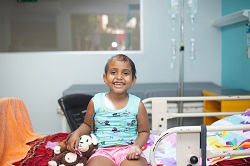 L’Association pour l’aide médicale en Amérique centrale AMCA Vaud soutient, depuis sa création en 2019, les projets de son association sœur basée au Tessin et met sur pied ses propres initiatives, plus spécifiquement dans le domaine de l’oncologie. Objectif : améliorer les soins et la qualité de vie des femmes et enfants atteints de cancer, alors que plus de 80% des cancers sont diagnostiqués dans les pays en développement et que le taux de mortalité y reste très élevé.
L’Association pour l’aide médicale en Amérique centrale AMCA Vaud soutient, depuis sa création en 2019, les projets de son association sœur basée au Tessin et met sur pied ses propres initiatives, plus spécifiquement dans le domaine de l’oncologie. Objectif : améliorer les soins et la qualité de vie des femmes et enfants atteints de cancer, alors que plus de 80% des cancers sont diagnostiqués dans les pays en développement et que le taux de mortalité y reste très élevé.
En 2022, nous programmons la construction d’un nouveau bâtiment de 26 lits pour un coût de 700 000 CHF. Ce projet représente la troisième étape de la restructuration de l’hôpital La Mascota à Managua (Nicaragua), hôpital de référence nationale pour la pédiatrie. Les années précédentes nous ont permis de construire un bâtiment pour le laboratoire d’hématologie, ainsi que de rénover l’hôpital de jour et un pavillon dédié aux enfants atteints de cancer. Les fonds récoltés par AMCA Vaud et son association sœur AMCA basée au Tessin permettent également de fournir des équipements médicaux, de promouvoir des études cliniques et la recherche, ainsi que de créer une plateforme d’échanges avec des spécialistes en Suisse. Depuis le début du soutien d’AMCA en 1985, le taux de survie chez ces jeunes patient-es est passé de 0% à 60% !
Consciente des effets néfastes du changement climatique sur la santé, notamment dans les pays les moins favorisés, AMCA Vaud a lancé un projet de pose de panneaux photovoltaïques sur le toit de l’hôpital pédiatrique La Mascota pour assurer une partie de la production en électricité de ses bâtiments. Une première centrale a été mise en fonction en 2021 et une seconde est prévue en 2022.
Enfin, AMCA Vaud a décidé de mettre sur pied un atelier de fabrication de prothèses mammaires externes dans le cadre de l’Hôpital Bertha Calderón à Managua, en partenariat avec le service psychosocial et les femmes nicaraguayennes atteintes d’un cancer du sein et ayant subi une mastectomie. Dès que la situation sanitaire le permettra, il est également prévu de créer des échanges entre les spécialistes sur place et suisses afin de permettre à ces femmes de bénéficier aussi de prothèses internes.
En 2022 et après l’obtention du label ZEWO, nous sommes encore plus motivés à consolider nos divers projets qui permettent de lutter contre l’inégalité face au cancer. Nous remercions nos membres et nos donatrices et donateurs pour leur soutien inestimable.
Contact:
Aurélie Michielin
Vice-présidente et responsable Communication
AMCA Vaud, Lausanne
Photo: ©AMCA Vaud - Yimber Gutiérrez Altamirano
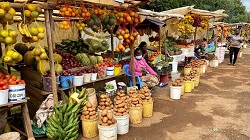 To improve health and reduce poverty amongst vulnerable city populations in Bangladesh, Kenya and Rwanda, a consortium of Swiss partners has launched the NICE project. NICE works with local authorities to empower women and youth leadership, while addressing both the demand and supply side of city food systems to promote nutritious, local, agroecologically produced foods.
To improve health and reduce poverty amongst vulnerable city populations in Bangladesh, Kenya and Rwanda, a consortium of Swiss partners has launched the NICE project. NICE works with local authorities to empower women and youth leadership, while addressing both the demand and supply side of city food systems to promote nutritious, local, agroecologically produced foods.
Launched in the run up to World Food Day in October 2021, the NICE project is initially focused on two secondary cities each in Bangladesh (Dinajpur, Rangpur), Kenya (Busia and Bungoma) and Rwanda (Rubavu and Rusizi).
NICE strengthens multisectoral exchange between city authorities, local businesses, markets and civil society across the domains of health, agriculture and education. According to city priorities, targeted to reach vulnerable women, youth and marginalized population groups, NICE started with a participatory process to select nutritious-focused value chains in each of the cities. Along these value chains, the project facilitates innovative social business models to increase agroecological production, while also harnessing consumer insights to influence demand. The involvement of women and youth in income-generating activities is actively encouraged, while steps are also being taken to ensure their safeguarding.
NICE aims to consolidate evidence-based, yet practical learnings across cities, to influence food system regulations and policies, and to share these experiences for wider dissemination and scale-up. To be able to monitor progress, NICE completed a city level baseline data collection exercise, together with local research partners. Data analysis according to differentials of gender and age has yielded important results. The populations in all the cities have experienced a decline in food security since the onset of the global pandemic, with women-headed households particularly affected.
It is planned to work with the cities to display key city nutrition indicators on publically accessible platforms for greater accountability. Some first insights from the baseline data were presented at the Food Day @ETH on 5 November 2021, winning the poster prize.
On 24 January 2022, the first virtual cross-country workshop has taken place in NICE, examining the steps taken to work across sectors, to select value chains according to criteria of both supply and demand, and to take a deeper dive into the project’s approach to youth engagement.
Helen Prytherch
NICE Project Coordinator, Swiss Tropical and Public Health Institute
Photo: Kenya market stalls © Syngenta Foundation/NICE Project
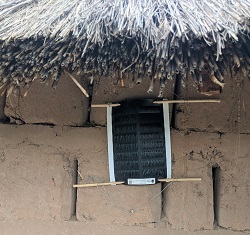
The recently published
World Malaria Report by the World Health Organization (WHO) has again shown that eradicating malaria remains a significant global challenge. The 2021 report estimated 241 million malaria cases and 627 000 malaria deaths worldwide in 2020 which represents about 14 million more cases in 2020 compared to 2019, and 69 000 more deaths.
In addition to the current challenges presented by the COVID-19 pandemic, a significant trend that has emerged in recent years is the growing incidence of outdoor biting. Mosquitoes are evolving leading to biting earlier in the evening before people enter their houses to sleep under bed nets or biting after sunrise. Changes in species composition and behaviour have also been observed towards the dominance of outdoor biting and resting species. This trend is also being exacerbated by changes in human behaviour, with more time being spent outside structures particularly early evening when vulnerable to outdoor biting, often driven by increased accessibility to electricity.
Whilst vector control tools such as bed nets and indoor residual sprays have traditionally targeted indoor biting mosquitoes, there is a significant gap in the malaria eradication toolbox for outdoor biting interventions.
SDC co-funds, with the Bill & Melinda Gates Foundation and UK Aid, the entomological and epidemiological impact evaluation of a new vector control tool to address this critical gap. This is an Attractive Targeted Sugar Bait (ATSB®) station developed by Westham company.
How ATSB works
Female mosquitoes take blood meals for egg production, but mosquitoes from both genders must feed regularly and frequently on sugar for energy to survive. Common sources of sugar meals include plant tissue and floral nectar. Two ATSB® bait stations are placed on exterior walls of houses and lure the mosquitoes with an attractant which contains a sugar source laced with an insecticide.
Large-scale proof-of-concept studies in 2016 and 2017 in Mali1, demonstrated a significant impact on mosquito density and survival. Since then, a manufacturing platform was established to produce enough testing material with a specific product design and quality. Modelling based on preliminary results anticipates that a 2-3% daily feeding rate on ATSB® would lead to a 30% decrease in malaria incidence.
A large campaign of entomological trials was performed in Zambia, Kenya and Mali in 2020 and 2021 to assess daily feeding rate in diverse ecological settings and also to confirm the bait station resilience when deployed in real field conditions (e.g., rain, dust, wind, temperature variations).
Start of Epidemiological Trials
The ATSB® project is now entering an exciting new phase with the start of three large scale epidemiological studies in malaria endemic countries. The Zambia trial began at the end of 2021 and will be followed by Kenya and Mali in March and April 2022. The trials are expected to run for two years. The data will then be submitted to the WHO and national regulators who will potentially grant approval to support its launch across sub-Saharan Africa in 2025.
Contact:
Chris Larkin
Director, Communications and Operations, IVCC
Photo: ATSB station secured on the exterior wall of a structure ©PATH
Healthcare workers need safe working conditions and adequate infrastructure to reduce the risk of health care-acquired infections and enhance the overall quality of care. The 2018 Global Call to Action on Water, Sanitation and Hygiene (WASH) in health care facilities by the UN Secretary General put the spotlight on disrepair and absence of critical infrastructure and equipment in facilities around the world, including wells, pumps, pipes, sinks, toilets and incinerators. Building upon the Global Call, all 194 WHO Member States approved a resolution on WASH in health care facilities at the 2019 World Health Assembly that calls on countries to establish baselines and set targets, embed WASH in key health programmes and budgets, to improve and maintain infrastructure and to regularly report on progress.
Since 2011, with support from the Swiss Agency for Development and Cooperation, the eight members of the Swiss Water and Sanitation Consortium (SWSC) have channelled their know-how and resources to improve water and sanitation services in communities in Africa and Asia. The Consortium’s third phase (2020-2023) prioritizes WASH in institutions, both schools and health care facilities. SWSC members HEKS, Helvetas, Swissaid and Terre des hommes are working with the government health services in Benin, Ethiopia, India, Mali, Myanmar, Nepal and Niger to advance national roadmaps for WASH in HCF.
At the core of SWSC’s approach to WASH in Health Care Facilities (HCF) is the Water and Sanitation for Health Facility Improvement Tool (
WASH FIT) launched in 2018 by WHO and UNICEF. WASH FIT is a risk-based management tool for health care facilities, covering key aspects of water, sanitation, hand hygiene, environmental cleaning, health care waste management and selected aspects of energy, building and facility management. The WASH FIT process convenes local actors to improve conditions by:
- Providing a framework to develop, monitor and continuously implement an infrastructure improvement plan and prioritize specific WASH actions;
- Guiding processes for planning and implementing WASH improvements as part of wider quality improvement efforts and to meet local, national and/or global standards;
- Bringing together all those who share responsibility for providing WASH services at national and sub-national levels, including policy-makers, district health officers, hospital administrators, water engineers and users.
SWSC and its local partners work with health care facility management committees and other local leaders to facilitate their lead in overseeing essential health care facilities functions, e.g. budgeting. Each facility conducts risk assessments and develops an Improvement Plan, prioritizing and presenting workstreams to local government and district health offices for planning, budgeting and supervision of works. Advocacy efforts by Consortium members have raised the profile of the WASH FIT methodology at the national level as an opportunity for health policymakers and regulators to monitor needs and progress at the sub-national level. This can also contribute to resource prioritisation, investments and budgeting.
In the past five years, SWSC members Terre des hommes, HEKS, Swissaid and Helvetas have worked in over 100 health care facilities in Africa and Asia, improving WASH service levels per indicators recommended by the WHO / UNICEF Joint Monitoring Programme (JMP). Key achievements include:
- WASH FIT: Introduction and piloting (for the first time) in Benin and Ethiopia, Nepal and Myanmar;
- Technical input to national standards and reference materials as part of the national WASH in HCF Task Force (Ministry of Health, Government of Mali;
- Adapting WASH FIT to the Government of Mali’s national strategy on COVID response
- Successful advocacy to influence municipalities, based on WASH FIT Improvement Plans, to mobilise and allocate funding and equipment to improve WASH Services in HCF in Mali, Myanmar and Nepal;
- Participation in a national working group for rolling out WASH FIT in Niger.
Collectively, the Swiss Water and Sanitation Consortium contributed to the following global publications on WASH in HCF:
The Swiss Water and Sanitation Consortium is also a member of advisory committees of the following global initiatives:
Contact:
John Brogan
Water Sanitation & Hygiene Advisor
Helvetas Swiss Intercooperation
Photo: As part of their WASH FIT process, the Community Health Association of Kokry in Mali's Segou Region mobilized funds, materials and labor to construct toilet blocks to end open defecation. The cost (~3,500 CHF) was covered entirely by the community and the municipality. ©Terre des Hommes
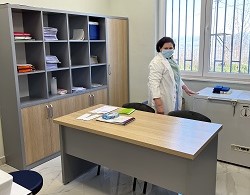 On 26 November 2019 Albania was hit by a 6.4 magnitude earthquake that caused the death of 51 people while hundreds were injured. According to the Post Disaster Needs Assessment Report1, the total effect of the disaster amounted to 985.1 million Euros. Switzerland provided a swift response to Albania’s call and pledged over 9 million Euros for specific support actions2.
On 26 November 2019 Albania was hit by a 6.4 magnitude earthquake that caused the death of 51 people while hundreds were injured. According to the Post Disaster Needs Assessment Report1, the total effect of the disaster amounted to 985.1 million Euros. Switzerland provided a swift response to Albania’s call and pledged over 9 million Euros for specific support actions2.
In the primary health sector, 22 facilities were affected by the earthquake of which 19 were partially damaged and 3 were fully destroyed thus over 45 000 people remained without or with limited primary health care services.
The SDC project, Health for All, supported the Ministry of Health and Social Protection to build from scratch two destroyed facilities in the most affected areas, namely a health center in Ishëm (Municipality of Durrës) and a second one in Borizanë (Municipality of Krujë). The investment of about 384 000 CHF includes planning and design, civil works, furnishing and purchase of medical equipment. As a result, more than 12 000 people are now receiving better health services thanks to a well-equipped and modern infrastructure.
During a recent visit to one of these facilities, the Minister of Health and Social Protection, Ogerta Manastirliu, expressed her gratitude on behalf of MoHSP for the high standards introduced by the project Health for All into the quality of PHC infrastructure and services. “I am very happy with the new Health Center of Borizanë, a modern facility with the best conditions an HC can have. This is a model of how all health centers in Albania should be” the minister added.
“Both patients and health professionals are more than happy and grateful to the Swiss people", says Dr. Mimoza Bushi, Director in the health center of Borizanë, "working in such improved conditions is a motivation for all of us to excel and achieve the best of ourselves.”
Irma Qehajaj
Communication Officer at Health for All Project
1 Albania: Post-Disaster Needs Assessment, February 2020
Photo:
©HAP
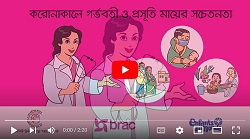 COVID-19 in Bangladesh
COVID-19 in Bangladesh
In Bangladesh, the first case of COVID-19 was reported on 8 March 2020. As the situation deteriorated rapidly, the government imposed a strict containment until the end of May 2020 heavily impacting the health programme supported by Enfants du Monde (EdM). Between April and October 2020 none of the following local activities could take place: training of BRAC community health workers, education sessions conducted by community health workers and community action groups. Moreover, our local partner Building Resources Across Communities (BRAC) was heavily mobilised and therefore had limited time to dedicate to the activities and the programme.
An impact on Maternal and Newborn Health
As a result of the COVID-19 pandemic and control efforts, the provision and utilisation of reproductive, maternal, newborn and child health services seemed to be affected. According to early estimates, the mortality rates for COVID-19 appeared to be low in women and children but the disruption of health systems and decreased access to food, would have generated additional maternal and under-5 child deaths, making the indirect effects of the outbreak more severe than the outbreak itself (Roberton T, Carter ED, Chou VB, et al. 2020, Kotlar, B., Gerson, E., Petrillo, S. et al. 2021). In addition, women, too scared to leave their homes, avoided seeking care during pregnancy, for birth and for postnatal check-ups. As reported by iMMAP in December 2021, the COVID-19 pandemic strongly impacted the utilisation of MNH services in Bangladesh, with for instance a worrying 31% decrease in antenatal care visits according to the United Nations Bangladesh (2020). Before the pandemic, ANC coverage used to be at 92 % which indicates a significant decrease following years of consistent progress. The COVID-19 has had an impact on skilled assisted delivery across the country: a two thirds (67%) decline in facility deliveries has been noticed at the beginning of 2020: from 78,259 facility deliveries in January 2020 down to 25,995 in May 2020 (iMMAP, 2021).
« The pandemic of COVID-19 was a very difficult time because I couldn't go out of my house much while I was pregnant and had to take care of my first child » explains Asma*, a 23-year-old pregnant mother, living in the Brāhmanbāria, Bangladesh. Like many women living in remote areas, Asma lives far from health centres and had very little information about the risks of pregnancy, and even less about the precautions to protect herself and her baby from COVID-19.
Enfants du Monde response to the first wave of COVID-19
Enfants du Monde has been active in Bangladesh in the field of MNH since 2007, mainly through training of community health workers and MNH education sessions. From May 2019 onwards, with the financial and technical support of EdM, our local partner BRAC has been implementing the project “Working with Individuals, Families and Communities to improve Maternal and Newborn Health in Bangladesh” at Sarail and Kasba subdistricts/upazillas in Brahmanbaria district, embedded into its Health, Nutrition and Population Programme.
From the beginning of the pandemic, in Bangladesh, BRAC and Enfants du Monde were deeply involved in supporting the Ministry of Health in the response to COVID-19, both in the programme area and at the national level. During the latency period when no activities could be carried out, BRAC and EdM conceptualized additional interventions adapted to the COVID situation, on two levels:
1) At community level, to provide information to the general population and mainly women on COVID-19, to ensure women are informed on how to protect themselves and others, to tackle the lack of scientific knowledge on Coronavirus and its impact on MNH:
- In addition to the material developed by the Ministry of Health, communication material was developed on MNH and COVID-19 in Bengali with local illustrations, to specifically target women, their needs and involve husbands: posters; leaflets; and stickers with a female health worker explaining services for pregnant mothers in the hospital during COVID-19. 355 000 posters, 500 000 stickers and 35 000 leaflets were distributed to households in BRAC/EdM intervention areas (market, bus stop, tea stalls, etc.) and in 31 Upazillas identified as a "red zone" by the government. In addition, a video animation regarding COVID-19 awareness for pregnant women was developed (Video 1). The animation was broadcasted on three well-known TV channels and posted on BRAC social media (YouTube & Facebook), receiving more than 576 500 views on Facebook. Finally, awareness-raising message on COVID-19 was disseminated in the EdM supported programme area through miking/announcements. The messages were broadcasted through large megaphone on top of tuk-tuk in all public places (market, bus stop, tea stalls, etc.) and residential areas.
- BRAC/EdM adapted the health education sessions for women led by BRAC community health workers to the context of the pandemic. The number of people participating in each courtyard session was reduced while the frequency was increased from one session per day to three. 229 830 households benefited from home visits, while 5 324 courtyard sessions were conducted with the participation of 70 637 people.
- More than 1 000 community leaders reached through existing community action groups were informed about COVID-19, with a focus on MNH, through the training initially planned for health care providers.
2) At health facility level, to provide protective equipment for healthcare providers and information on how to use it:
- Primary health care providers were trained on COVID-19, with a focus on MNH, through the BRAC local trainers. 69 community health care providers and family welfare visitors were trained.
- Personal protective equipment (PPE), and notably 400 goggles, 3 600 masks, 2 500 gloves and 1 000 protective suits were distributed to health care providers of the hospital and community clinics of Brahambaria. Masks were also distributed to over 47 000 BRAC community health workers. The PPE distribution was accompanied by an orientation on the use of this equipment.
EdM and its partner BRAC also used this latency period to conceptualize key programme activities such as the distance learning of Ministry of Health managers and the process of Active Citizen Participation for the clinical audits of health facilities.
Collaboration with our local partner
The activities in Bangladesh were implemented thanks to BRAC's local anchoring and especially the female frontline community health workers locally recruited and trained to deliver door-step health service: health education session, household visits and meetings with the wider community. This proximity with community enabled a response fitting the local needs despite the complexity of the epidemiological situation. The BRAC training unit, the BRAC Health team in close collaboration with EdM gave technical and financial support. The local communities gave inputs to steer the development of communication material. Health providers and district health officers collaborated for the health facility component. The Civil Surgeon in Brahambaria (responsible for the two sub-districts of the programme) was involved in every step of the process and received PPE equipment for distribution according to the most pressing needs.
Lessons learnt
« The COVID-19 pandemic is disrupting the delivery of essential and lifesaving health services. The crisis has caused a particularly distressing drop in access to maternal, neonatal, child and adolescent health and nutrition, family planning and immunization services, threatening progress on maternal and new-born health indicators that were already stagnating before the pandemic », reported the United Nation Bangladesh in 2020.
The strong mobilisation of Enfants du Monde and its local partner in a focused area seems to have contributed to limit the impact of COVID-19 on MNH in 2020. Despite the expected decrease in the use of SMN services at country level, several MNH indicators remained high in the programme intervention area. In 2020, according to data drawn by the programme from a limited sample of women, the percentage of deliveries conducted by skilled health providers increased by 2% compared to 2019, and was at 65%. According to a survey conducted by EdM, the percentage of women receiving four antenatal visits continued to increase and reached 38% in 2020 (29% in 2019). Such progressing trend hasn’t been observed at the country level, where skilled assisted delivery and ANC coverage were strongly impacted by COVID-19 (iMMAP, 2021).
The rapid and meaningful adaptation of our Health programme in Bangladesh was possible thanks to an array of factors: a pre-existing trust relationship with our local partner organisation; strong links and collaboration with the Ministry of Health; BRAC’s community anchorage; and EdM’s capacity to rapidly mobilize its own technical staff and network and to leverage additional SDC funds. These collaborative efforts enabled EdM and its local partner to propose innovative, pragmatic and flexible responses to the multiple challenges caused by COVID-19, strengthening our support to the most vulnerable communities. We strengthened knowledge, skills and capacities of local actors in the fight against pandemics. By equipping health care providers and building capacities in health facilities, we enabled them to support pregnant women and young mothers, despite the epidemiological situation. Through health education and promotion, we helped women, men, families and communities, whether literate or not, to have access to reliable information and to take action to improve MNH in the context of COVID.
*Allowed name to protect the identity of the beneficiaries, testimony collected by BRAC in December 2020
Articles:
- Fogstad, H. (2021). Women, children, and adolescents in the post-pandemic world. The Lancet, 397(10285), 1620.
- Kotlar, B., Gerson, E., Petrillo, S. et al. The impact of the COVID-19 pandemic on maternal and perinatal health: a scoping review. Reprod Health 18, 10 (2021).
- Roberton, T., Carter, E. D., Chou, V. B., Stegmuller, A. R., Jackson, B. D., Tam, Y., ... & Walker, N. (2020). Early estimates of the indirect effects of the COVID-19 pandemic on maternal and child mortality in low-income and middle-income countries: a modelling study. The Lancet Global Health, 8(7), e901-e908.
Reports:
- iMMAP, «The effects of COVID-19 on Sexual and Reproductive Health: A Case Study of Six Countries», published in December 2021, consulted in February 2022.
- UNDP « Addressing COVID-19's uneven impacts on vulnerable populations in Bangladesh: The case for shock-responsive social protection», Development Futures Series: Covid-19, Published in March 2021, consulted in January 2022
- UNICEF, UNFPA, WHO and SickKids' Center for Global Child Health, «Report: Direct and indirect effects of COVID-19 pandemic and response in South Asia», published in March 2021, consulted in January 2022
- United Nations in Bangladesh, Immediate Socio-economic Response Plan (ISERP). Published in September 2020, consulted in January 2022
Contact:
Kosovo | The KOSCO Cohort – An Innovative Evaluation and Research Infrastructure
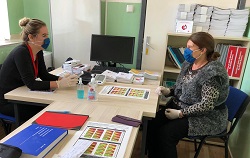
AQH Project – The Framework for the nested KOSCO Cohort
The Kosovo Accessible Quality Healthcare (AQH) is a project of the Swiss Agency for Development and Cooperation (SDC), implemented by the Swiss Tropical and Public Health Institute (Swiss TPH). Its aim is to work with local stakeholders to improve the quality of Primary Health Care (PHC) in the public health sector, with a focus on the prevention of non-communicable diseases (NCDs), and in particular of cardiovascular and metabolic diseases.
In Kosovo, the public PHC system is divided into three tiers: each municipality has one main family medicine centre (MFMC), several family medicine centres (FMC) and several family medicine ambulantas (FMA). MFMCs are the largest facilities at the highest level of PHC, which offer more services, employ more staff and have more medical equipment and therefore have a higher patient flow compared with the second-level FMCs and third-level FMAs. There is also the private PHC sector with only one tier consisting of private clinics. MFMCs were therefore the target for starting the implementation of service packages based on the WHO ‘Packages of Essential Non-Communicable Disease (PEN) Protocols`, which have been adapted to the Kosovo context.
The service packages ensure a continuum of care with the family physician in a gatekeeper role, where patients who are at risk of developing diabetes or hypertension, or those who have already been diagnosed are referred to a health educator for one-to-one motivational counselling sessions to facilitate behaviour change. Since May 2018, specially trained nurses provide one-to-one motivational counselling sessions according to Kosovo adapted ‘5 A’s Clinical Practice Guideline’ (Ask, Advice, Assess, Assist and Arrange) to facilitate behavioral change in the domains of smoking, diet, alcohol use and physical inactivity for patients who are at risk of developing diabetes or hypertension, or those who have already been diagnosed.
Need for NCD data in Kosovo
A rapid assessment of the PHC system in Kosovo conducted by the World Health Organisation (WHO) in 2019 found that hospitalizations related to hypertension and diabetes decreased rapidly between 2012 and 2016, indicating major improvements in disease management in general. However, life expectancy gap between Kosovo and its neighbours still existss in 2021. Yet, little evidence is available for the frequency of hypertension, diabetes and their risk factors in the general population. Less even is known about how well hypertension and diabetes are detected and controlled after a diagnosis.
The KOSCO Cohort of public sector Primary Health Care Center users – its potential
The KOSCO cohort was subsequently implemented since 2019, with the following main objectives:
- To assess the prevalence of NCDs such as hypertension and diabetes, as well as other potentially important NCDS (mental disorders; chronic obstructive pulmonary disease (COPD); asthma; musculoskeletal problems), as well as the prevalence and temporal change of risk factors, disease control and under-diagnosis of these NCDs.
- To evaluate the longitudinal relationship of AQH non-experimental interventions such as motivational counselling sessions with adherence to healthy lifestyles (physical activity, nutrition, smoking, alcohol consumption), clinical measurements (blood pressure, BMI and HbA1c) and the stage of health behaviour change.
- In addition, the cohort is a valuable long-term research infrastructure for broad graduate and post-graduate training and strengthens international research collaboration of Kosovo and Switzerland.
Overall the cohort helps to identify in a longitudinal and long-term manner areas for improvement in the prevention and control of hypertension and diabetes along the chain of care, ie. in primary, secondary and tertiary prevention. Specifically, it assesses participants lifestyles and behaviours over time, it studies the diagnostic procedures including timing of diagnosis, and importantly also how well a diagnosed disease is controlled as a result of treatment and adherence to medical advice.
The KOSCO Cohort – its structure
Recruitment and baseline data collection were conducted between March and November 2019. A total of 8.330 consecutive MFMC users were approached of whom 1.011 consented to participate and were included in the cohort. Ethical approvals were obtained from the Ethics Committee Northwest and Central Switzerland (Ref. 2018-00994) and the Kosovo Doctors Chamber (Ref. 11/2019).
Participants were included in the cohort if they were aged 40 years or older and consulted healthcare services irrespective of the reason on the day of recruitment. Participants were excluded from the cohort if they had a terminal illness, were not able to understand or respond to screening questions in Albanian or Serbian, did not live in one of the 12 study municipalities, or lived abroad for more than six months of the year.
Follow-up assessments of the cohort participants are since conduced spaced by approximately six months, switching between an in-person interview and health examination on the one hand, and telephone interviews on the other hand. Despite the challenges of the COVID-19 pandemic a high participation rate of over 65% of baseline participants could be maintained by 2021. New participants will be recruited in 2021 to maintain the size of the cohort and to allow investigating time trends in the prevalence of NCD risk factors as well as underdiagnosis and control of disease in the context of repeated surveys.
Data points of the cohort
Participant characteristics obtained through in-person or telephone interviews include socio-demographic characteristics; disease diagnoses and relevant health symptoms (i.e. respiratory symptoms, symptoms of depression, anxiety, and stress, symptoms of cardiovascular disease and diabetes); personality aspects (e.g. resilicience; self-efficacy); lifestyle (e.g. physical activity, tobacco smoking, nutritional aspects, alcohol consumption); environmental aspects at the residence; health literacy; health care and motivational counselling utilization; satisfaction with care and counselling; treatment adherence; motivational stages of change related to smoking, physical activity, fruit/vegetable consumption, and alcohol consumption.
Health measurements conducted once per year include blood pressure, height, weight, waist/hip/neck circumferences, HbA1c, and peak expiratory flow.
Baseline findings
At the baseline assessment in 2019 the results of KOSCO point to alarmingly high levels of NCD risks. In particular, 21% of participants smoked, 70% were physically inactive, 85% reported insufficient fruit and vegetable consumption, and 53% were obese. In contrast to these high risks, only 4% of the participants reported any alcohol consumption within the last month, in line with the predominantly Muslim culture of the country. The frequency of these NCD risks remained basically unaltered by February 2021. First results comparing the frequency of these NCD risks between municipalities and participants receiving or not receiving motivational counselling sessions do not yet point to relevant differences. Accordingly, most of the cohort participants have not yet moved to active motivational stages of behaviour change. In the context of detailed qualitative interviews with 26 participants recruited from the KOSCO cohort, barriers limiting the opportunity for change of lifestyle were identified, such as the lack of adequate space for being physically active. This result points to the need for health-in-all-policy dialogue.
The observed prevalences of hypertension (62%) and diabetes (52%) at the baseline examination were high in PHC users aged 40 years and older. Of particular concern, 19% and 16% of persons with hypertension and diabetes, respectively, were not aware of their high blood pressure and hyperglycemia before they were screened in the context of the KOSCO baseline examination. Among the participants who had previously obtained a doctor’s diagnosis of hypertension, 28% did not have their blood pressure controlled at baseline. Among the participants who had previously obtained a doctor’s diagnosis of diabetes, 79% did not have their blood pressure controlled at baseline. These results form the basis for a learning system, as they are regularly brought to the attention of the local MFMC physicians.
A potentially important barrier to NCD prevention and control is poor mental health. Depression has been associated with poor lifestyle, with health-seeking behaviour and with adherence to treatment and therefore disease control. In KOSCO, the level of moderate-to-very-severe depression symptoms was about 10%. Participants with higher levels of depressive symptoms were more physically inactive, but were less likely to have their diabetes not detected. These results point to the need of future PHC interventions on NCDs to integrate a mental health component.
Respiratory symptoms and peak expiratory flow data were obtained in the KOSCO cohort. Lung function tests combined with questions about a doctor’s diagnosis suggest a prevalence of COPD of roughly 6%, but in fact 45% of these participants were not aware of their respiratory problem. The high rates of airflow obstruction are not surprising in the light of high smoking rates and high levels of air pollution, particularly in winter as a result to a large percentage of wood- and coalburning by households.
KOSCO Cohort – a fast reacting surveillance tool
Due to the contact with KOSCO participants in the context of closely spaced follow-up assessments and given the availability of study nurses with longer-term contracts it was possible to integrate relevant questions related to the COVID-19 pandemic. KOSCO offers the opportunity to provide evidence on the adherence and perception of containment measures and of vaccination. In particular, it allows assessing the short- and longer-term impact of the pandemic and its containment measures on lifestyle, mental health and access to health services.
KOSCO Cohort – National and International Visibility
The results of the KOSCO Cohort are regularly presented at national and international public health conferences. Most importantly, the findings are discussed and evaluated in close collaboration with local medical, policy, and academic stakeholders in Kosovo, to thereby use the evidence for adapting counselling and treatment approaches and to stimulate additional research collaboration as well as local ownership for the KOSCO infrastructure.
Article by:
Katrina Obas1,2, Ariana Bytyci-Katanolli1,2, Qamile Ramadani3, Nicu Fota3, Naim Jerliu4,5, Shukrije Statovci6, Jana Gerold7, 2, Manfred Zahorka7, 2, Nicole Probst-Hensch1,2
1 Department of Epidemiology and Public Health, Swiss Tropical and Public Health Institute, Basel, Switzerland; 2 University of Basel, Basel, Switzerland; 3 Accessible Quality Healthcare Project, Prishtina, Kosovo; 4 National Institute of Public Health, Prishtina, Kosovo; 5 Medical Faculty, University of Prishtina, Prishtina, Kosovo; 6 University Clinical Centre of Kosovo, Prishtina, Kosovo; 7 Swiss Center for International Health, Swiss Tropical and Public Health Institute, Basel, Switzerland
Contact: Nicu Fota
Team Leader AQH
Photo: ©K. Obas, KOSCO project
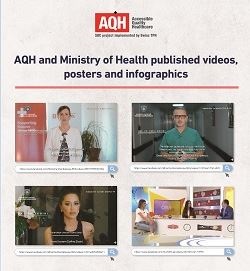 Conspiracy theories about COVID-19 vaccines have spread widely around the world but found fertile ground in Kosovo and the region.
Conspiracy theories about COVID-19 vaccines have spread widely around the world but found fertile ground in Kosovo and the region. Whereas now, Kosovo leads in the Western Balkans in terms of vaccination rates, with 53% of the population fully vaccinated. Culturally congruent communication campaigns where AQH Project was involved were one of the high impact tools that contributed to the uptake of vaccination.
To this context, since the beginning of the pandemic, AQH supported the Ministry of Health in the development and dissemination of COVID-19 vaccination communication campaigns while designing more than 20 videos and a higher number of posters and infographics. While assembling a group of renowned public health experts, the aim was to empower people to make evidence-informed choices about COVID-19 vaccination, encourage trust in health authorities, raise awareness for the trusted channels of communication and address concerns of the population. Influencers, ambassadors, trusted journalists and other reputable people joined the AQH communication campaigns by giving clear and simple messages encouraging positive vaccination behaviour. Up to 1 million people were reached through AQH and stakeholders social media pages with specific posts.
Among these, TV news channels have been one of the most used sources of COVID-19 news, therefore the project and MoH team were guests in TV Shows to create public awareness on hygiene measures and appropriate behaviour, as well as the campaigns were transmitted several times per day in all national TV and Radio stations.
As the situation with the pandemic is evolving continually, the project remains committed to support national institutions in their fight against COVID-19.
Contact:
Zana AqifiSenior Communication Officer at AQH Project, Kosovo
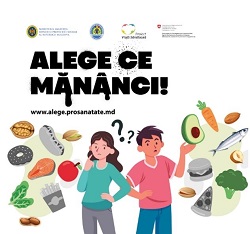 The first phase of the Healthy Life Project (HLP) was implemented during 2016 and 2020 with the overall goal, to contribute to the improvement of the health status of the Moldovan population, by reducing the burden of NCDs, especially in rural areas. The project achieves this through the implementation of evidence-based updates of clinical and managerial standards (e.g. WHO PEN-Protocols), the enablement of innovative approaches in health promotion, primary health care and integrated care, capacity building and support of planning, coordination and community-level partnerships for health, as well as the active generation of evidence and its dissemination.
The first phase of the Healthy Life Project (HLP) was implemented during 2016 and 2020 with the overall goal, to contribute to the improvement of the health status of the Moldovan population, by reducing the burden of NCDs, especially in rural areas. The project achieves this through the implementation of evidence-based updates of clinical and managerial standards (e.g. WHO PEN-Protocols), the enablement of innovative approaches in health promotion, primary health care and integrated care, capacity building and support of planning, coordination and community-level partnerships for health, as well as the active generation of evidence and its dissemination.
Two KAP surveys on the target NCDs (diabetes, hypertension and ischemic heart disease) and their respective risk factors were conducted, which also collected additional information regarding the population’s health information-seeking behaviour and satisfaction with health services, as well as the population’s knowledge about patient rights, and a general assessment of health literacy. A total of 930 and 945 respondents participated in the KAP surveys in 2017 and 2020 respectively.
Within the first three years of the project’s activities, the population’s awareness of NCDs and the respective risk factors increased. An overall reduction in the consumption of sugary foods and drinks, and salty snacks points towards positive impacts of the project’s health promotion activities. At the same time, the study identified an increase in the consumption of fruits and vegetables in the surveyed population in 2020.
Despite these positive trends identified, data from the two surveys show that there are 6 in 10 adults considered “overweight” with a BMI above 25 in 2017 and 2020. This finding not only means that real change needs time. It also highlights the need to continue activities related to health promotion, by targeting individual behaviour, but also keeping structural factors in mind, such as access to fresh vegetables and fruits in all seasons, which was worrying low in 2020, especially in older adults aged 45-69 and people suffering from NCDs.
Now in phase 2, the HLP supports a multi-sectoral Communication Platform to adjust regulations and engages in the development of a supportive environment for changing nutritional behaviour.
As this example shows, with the integration of new questions in the KAP surveys, other thematic areas of action can be identified. Data helps the project to innovate and improve the programmatic design in its next phases, through targeted, evidence-based actions towards our overall goal: To improve the health of the population, especially the most vulnerable ones.
Article by:
Ala Curteanu, Constantin Rimis, Lilia Onea, Meike-Kathrin Zuske, Helen Prytherch
Contact:
Valeriu Sava
National Program Officer Health, Swiss Cooperation Office in Moldova
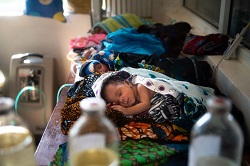 With 25 deaths per 1000 live births, neonatal mortality rate in Tanzania is still significantly higher than the Sustainable Development Goals’ target of 12 per 1000 live births by 2030. Responding to this challenge, in January 2022 SolidarMed started a 3-year project called “A Good Start", which aims at increasing the survival rate of newborn in three hospitals in the Morogoro Region, Tanzania.
With 25 deaths per 1000 live births, neonatal mortality rate in Tanzania is still significantly higher than the Sustainable Development Goals’ target of 12 per 1000 live births by 2030. Responding to this challenge, in January 2022 SolidarMed started a 3-year project called “A Good Start", which aims at increasing the survival rate of newborn in three hospitals in the Morogoro Region, Tanzania.
Three out of four neonatal deaths occur within the first week of life. We thus focus on this crucial time and the identified key problems of newborn in this context: neonatal infections, hypothermia, asphyxia, respiratory distress, and feeding difficulty. “A Good Start” builds on the achievements of a SolidarMed project that was implemented in Lugala hospital, one of the district hospitals in this area. Through investment in infrastructure and life-saving equipment, followed by capacity building and mentoring of health staff this project succeeded to increase survival rate among preterm and low birth weight neonates from 76% in 2019 to 91% in 2021. Lugala is now the only hospital in the region that has a dedicated Kangaroo Mother Care (KMC) and a newborn intensive care ward (NICE) to manage the most frequent health challenges in neonates. Community sensitization created huge demand and acceptability of the specific neonatal health services by the communities: even women who gave birth at home started bringing their newborn to Lugala hospital.
The project “A Good Start” will improve neonatal survival at two districts and the regional hospital of Morogoro, covering a population of 2.73 million. Each year, 12 000 newborn, including 2 400 preterm and low birthweight babies will benefit from improved health services.
Implementation starts with a structured baseline assessment to define the current provision of neonatal care for low birthweight, preterm, and other at-risk newborn at the 3 selected health facilities. This will include establishing an inventory of the available infrastructure and equipment; assessing the training levels and needs of staff; performing structured observations of clinical practice; and analysis of neonatal death audits. Where deemed necessary, this will be further complemented with interviews with selected health staff, hospital management and women who recently gave birth to a baby in one of these hospitals.
We apply a phased approach with stepwise introduction of evidence-based interventions. This allows implementation research by comparing the neonatal health outcomes per hospital over time.
During the project, all targeted hospitals will benefit from the full package of services, which include:
- Infrastructure and equipment improvement: construction of both a KMC and a NICE room at each hospital. The NICE room will be equipped with a CPAP (Continuous Positive Airway Pressure) machine to support breathing and improve neonatal survival. Additional essential apparatus such as nasogastric tubes and oxygen concentrators will complement the equipment.
- Development of an Infection Prevention and Control protocol (based on existing national guidelines and WHO standards) that is adapted to consider specific aspects of the hospital and implemented through dedicated trainings for all maternity, KMC and NICE staff.
- Capacity building of health staff in newborn care and counselling techniques for adoption of KMC, neonatal emergency resuscitation, newborn care. After initial training, staff will have hands-on-sessions, demonstrations, and simulation scenarios. Each participant will receive a structured program for mentoring and supportive supervision and team meetings will be organized to discuss quality improvement opportunities. Performance of staff and training impact will be evaluated in a standardized way before and at several moments after the training.
- Monitoring and systematic documentation of the implementation process and activities in the hospital. This will include detailed reporting on the infrastructure and equipment investments including time spent, the process followed to implement the Infection Prevention and Control protocols and full training records for staff. Detailed tracking of the itemized costs per intervention is included. The monitoring system to evaluate neonatal care will be refined with our partners and implemented within the existing health information system. The scientific expertise for a robust but simple monitoring will be provided by the Ifakara Health Institute, a leading national research institute with a strong track record in innovative research projects and scientific publications. A set of essential indicators will be defined and tracked on a monthly basis. Primary outcome measures include neonatal survival and neonatal mortality rate per health facility. Secondary outcome measures focus on the success rate of neonatal resuscitation; the number of neonatal infections per hospital; proportion of newborn who started breastfeeding within 1 hour after birth; number of newborn benefitting from breathing support through a CPAP machine.
- Follow-up of neonates after discharge from the hospital: To add knowledge on the outcome of “at risk” newborn after discharge from the hospital, follow-up home visits will be conducted. A physical examination of the child and a structured interview with the mother will provide relevant information on survival and health of the newborn.
The project is managed by SolidarMed in close collaboration and exchange with the national health authorities and the Ifakara Health Institute. It is funded by the Else Kröner-Fresenius-Stiftung, the SDC programme contribution to SolidarMed and other resources. Evidence and project achievements will be shared with decision-makers to foster transition to further scale-up.
Contact:
Dr Karoline Pfeiffer
SolidarMed
Photo: Newborn in Kangaroo Mother Care unit, Lugala Hospital, 2020 @Roshni Lodhia
